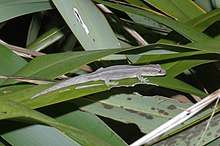Stephen's Island gecko
The Stephen's Island gecko (Toropuku stephensi), also known commonly as the Cook Strait striped gecko,[3] Stephen's sticky-toed gecko, and the striped gecko, is a species of gecko in the monotypic genus Toropuku in the family Diplodactylidae. The species is endemic to New Zealand.
| Stephen's Island gecko | |
|---|---|
 | |
| Stephen's Island gecko on Maud Island in the Marlborough Sounds | |
| Scientific classification | |
| Kingdom: | Animalia |
| Phylum: | Chordata |
| Class: | Reptilia |
| Order: | Squamata |
| Family: | Diplodactylidae |
| Genus: | Toropuku Nielsen, Bauer, Jackman, Hitchmough & Daugherty, 2011 |
| Species: | T. stephensi |
| Binomial name | |
| Toropuku stephensi (Robb, 1980) | |
| Synonyms[2] | |
| |
Etymology
The specific name, stephensi, refers to Stephens Island, New Zealand.[4]
Taxonomy
The holotype of T. stephensi is in the collection of the Museum of New Zealand Te Papa Tongarewa.[5]
Habitat
The preferred natural habitats of T. stephensi are forest and shrubland, at altitudes from sea level to 225 m (738 ft).[1]
Reproduction
T. stephensi is viviparous.
Conservation status
As of 2012 the Department of Conservation (DOC) classified the Stephen's Island gecko as Nationally Vulnerable under the New Zealand Threat Classification System.[3]
References
- Hitchmough R, van Winkel D, Lettink M, Chapple D (2019). "Toropuku stephensi ". The IUCN Red List of Threatened Species 2019: e.T10253A120187688. Downloaded on 19 July 2019.
- Species Toropuku stephensi at The Reptile Database www.reptile-database.org.
- Hitchmough, Rod; Anderson, Peter; Barr, Ben; Monks, Jo; Lettink, Marieke; Reardon, James; Tocher, Mandy; Whitaker, Tony. "Conservation status of New Zealand reptiles, 2012" (PDF). Department of Conservation. The Government of New Zealand. Retrieved 18 July 2015.
- Beolens, Bo; Watkins, Michael; Grayson, Michael (2011). The Eponym Dictionary of Reptiles. Baltimore, Maryland: Johns Hopkins University Press. xiii + 296 pp. ISBN 978-1-4214-0135-5. (Hoplodactylus stephensi, p. 253).
- "Hoplodactylus stephensi Robb, 1980; holotype". Collections Online. Museum of New Zealand Te Papa Tongarewa. Retrieved 17 July 2010.
Further reading
- Nielsen, Stuart V.; Bauer, Aaron M.; Jackman, Todd R.; Hitchmough, Rod A.; Daugherty, Charles H. (2011). "New Zealand geckos (Diplodactylidae): Cryptic diversity in a post-Gondwanan lineage with trans-Tasman affinities". Molecular Phylogenetics and Evolution 59 (1): 1-22. (Toropuku, new genus; T. stephensi, new combination).
- Robb, Joan (1980). "Three new species of gekkonid lizards, genera Hoplodactylus Fitzinger and Heteropholis Fischer, from New Zealand". Nat. Mus. New Zealand Rec. 1 (19): 305–310. (Hoplodactylus stephensi, new species).
- Rösler H (2000). "Kommentierte Liste der rezent, subrezent und fossil bekannten Geckotaxa (Reptilia: Gekkonomorpha)". Gekkota 2: 28–153. (Hoplodactylus stephensi, p. 90). (in German).
External links
- Hoplodactylus stephensi The IUCN Red List of Threatened Species 2016–3.
| Wikispecies has information related to Toropuku stephensi |
